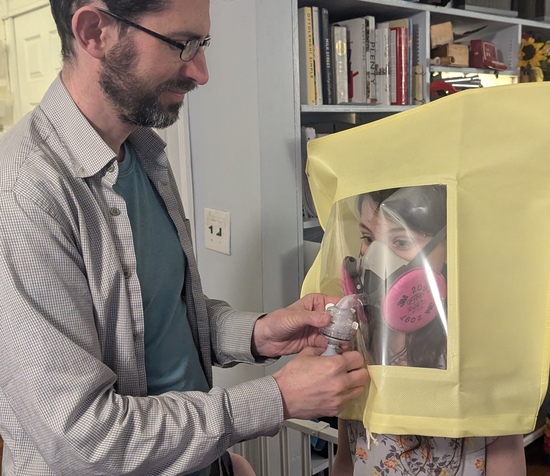Qualitative Fit Testing |
May 22nd, 2025 |
| masks |
There are a range of ways to see if a mask fits. A good first test is to put it on and see if you feel air leaking around it. If it's possible to cover the intake you can breath in while wearing it, and you should feel it pull tight against your face. These tests are often enough to rule out masks, and are pretty quick.
Once you've identified a mask you think is plausibly a good fit you can do qualitative fit testing. The idea is, you make some particles with a strong taste or smell, and see how well they can get in while you're wearing the mask. If they can't get in, especially as you move your head around, talk, and grimace, then your seal is pretty good. I got a kit (Gerson QLFT50M) which included several components:
A hood the test subject wears over their head, so you don't need to fill the whole room with particles.
Saccharin (sweet) or Bitrex (bitter) solution, which have a strong taste you should notice clearly if it makes it through the mask.
A squeeze-bulb nebulizer, to turn the strong-tasting liquid into tiny strong-tasting particles.
You put the liquid in the nebulizer, poke the nebulizer through a hole conveniently provided in the front of the hood, and squeeze out particles.
One key thing about the setup is there are two solutions and two nebulizers. One is the weaker sensitivity solution, which you breathe maskless to ensure you can detect the test particles, and the other is a stronger [1] test solution, which ideally doesn't make it through the mask in detectable quantities.
While this seems to be a common design, I really don't like how it relies on the two nebulizers performing identically. Especially since initially mine didn't: the sensitivity testing nebulizer worked great (easy to squeeze, you can see the little bubbles going, fine mist) while the fit testing nebulizer worked much less well (harder to squeeze, needed more adjustment, much less little bubble movement, less mist). After people went home I played with the nebulizers and got a better feel for how to adjust them to get them both performing well. This would have been good to do before!
I'm planning to bring the masks and test kit to LessOnline, which I expect to be enriched for people who would be interested in this sort of thing.
[1] You use a much
larger difference for saccharin (100x in the fit test) than Bitrex
(12.5x). I'm still confused about this, but some asking Gemini
suggests it's because "the 'low, but generally detectable'
concentration and the 'significantly stronger, but not unbearable'
concentration are vastly different relative to each other for these
two substances due to their intrinsic taste properties."
Comment via: facebook, lesswrong, mastodon, bluesky, substack
